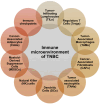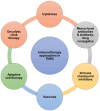Present and Future of Immunotherapy for Triple-Negative Breast Cancer
- PMID: 39409871
- PMCID: PMC11475478
- DOI: 10.3390/cancers16193250
Present and Future of Immunotherapy for Triple-Negative Breast Cancer
Abstract
Triple-negative breast cancer (TNBC) lacks the expression of estrogen receptors (ERs), human epidermal growth factor receptor 2 (HER2), and progesterone receptors (PRs). TNBC has the poorest prognosis among breast cancer subtypes and is more likely to respond to immunotherapy due to its higher expression of PD-L1 and a greater percentage of tumor-infiltrating lymphocytes. Immunotherapy has revolutionized TNBC treatment, especially with the FDA's approval of pembrolizumab (Keytruda) combined with chemotherapy for advanced cases, opening new avenues for treating this deadly disease. Although immunotherapy can significantly improve patient outcomes in a subset of patients, achieving the desired response rate for all remains an unmet clinical goal. Strategies that enhance responses to immune checkpoint blockade, including combining immunotherapy with chemotherapy, molecularly targeted therapy, or radiotherapy, may improve response rates and clinical outcomes. In this review, we provide a short background on TNBC and immunotherapy and explore the different types of immunotherapy strategies that are currently being evaluated in TNBC. Additionally, we review why combination strategies may be beneficial, provide an overview of the combination strategies, and discuss the novel immunotherapeutic opportunities that may be approved in the near future for TNBC.
Keywords: TNBC; chemotherapy; immune checkpoint inhibitors; immunotherapy; radiation therapy; triple-negative breast cancer.
Conflict of interest statement
S.S., S.T., S.N.: no COIs; C.S.: Exact Sciences (paid consultant—no direct conflict).
Figures



Similar articles
-
Progress and pitfalls in the use of immunotherapy for patients with triple negative breast cancer.Expert Opin Investig Drugs. 2022 Jun;31(6):567-591. doi: 10.1080/13543784.2022.2049232. Epub 2022 Mar 9. Expert Opin Investig Drugs. 2022. PMID: 35240902 Review.
-
Progress and Prospect of Immunotherapy for Triple-Negative Breast Cancer.Front Oncol. 2022 Jun 20;12:919072. doi: 10.3389/fonc.2022.919072. eCollection 2022. Front Oncol. 2022. PMID: 35795050 Free PMC article. Review.
-
Pembrolizumab and atezolizumab in triple-negative breast cancer.Cancer Immunol Immunother. 2021 Mar;70(3):607-617. doi: 10.1007/s00262-020-02736-z. Epub 2020 Oct 5. Cancer Immunol Immunother. 2021. PMID: 33015734 Free PMC article. Review.
-
Recent Advances in Immunotherapy and Targeted Therapy of Triple Negative Breast Cancer.Curr Pharm Biotechnol. 2025;26(3):365-391. doi: 10.2174/0113892010303244240718075729. Curr Pharm Biotechnol. 2025. PMID: 39092645 Review.
-
Immunotherapy in triple-negative breast cancer: Insights into tumor immune landscape and therapeutic opportunities.Front Mol Biosci. 2022 Aug 19;9:903065. doi: 10.3389/fmolb.2022.903065. eCollection 2022. Front Mol Biosci. 2022. PMID: 36060249 Free PMC article. Review.
Cited by
-
Development of a prognostic model based on four genes related to exhausted CD8+ T cell in triple-negative breast cancer patients: a comprehensive analysis integrating scRNA-seq and bulk RNA-seq.Discov Oncol. 2025 Feb 3;16(1):114. doi: 10.1007/s12672-025-01812-z. Discov Oncol. 2025. PMID: 39899181 Free PMC article.
-
Druggable Molecular Networks in BRCA1/BRCA2-Mutated Breast Cancer.Biology (Basel). 2025 Mar 2;14(3):253. doi: 10.3390/biology14030253. Biology (Basel). 2025. PMID: 40136510 Free PMC article. Review.
-
Advancing Breast Cancer Treatment: The Role of Immunotherapy and Cancer Vaccines in Overcoming Therapeutic Challenges.Vaccines (Basel). 2025 Mar 24;13(4):344. doi: 10.3390/vaccines13040344. Vaccines (Basel). 2025. PMID: 40333213 Free PMC article. Review.
-
Exploratory Research for HIF-1α Overexpression Tumor Antigen in the Activation of Dendritic Cells and the Potent Anti-Tumor Immune Response.Cancer Manag Res. 2024 Dec 17;16:1813-1822. doi: 10.2147/CMAR.S482363. eCollection 2024. Cancer Manag Res. 2024. PMID: 39713567 Free PMC article.
-
Delphi consensus on the management of adverse events in patients with metastatic triple-negative breast cancer treated with sacituzumab govitecan.Oncologist. 2025 May 8;30(5):oyaf088. doi: 10.1093/oncolo/oyaf088. Oncologist. 2025. PMID: 40366333 Free PMC article.
References
-
- Bauer K.R., Brown M., Cress R.D., Parise C.A., Caggiano V. Descriptive analysis of estrogen receptor (ER)-negative, progesterone receptor (PR)-negative, and HER2-negative invasive breast cancer, the so-called triple-negative phenotype: A population-based study from the California cancer Registry. Cancer. 2007;109:1721–1728. doi: 10.1002/cncr.22618. - DOI - PubMed
-
- Liedtke C., Mazouni C., Hess K.R., Andre F., Tordai A., Mejia J.A., Symmans W.F., Gonzalez-Angulo A.M., Hennessy B., Green M., et al. Response to Neoadjuvant Therapy and Long-Term Survival in Patients with Triple-Negative Breast Cancer. J. Clin. Oncol. 2023;41:1809–1815. doi: 10.1200/JCO.22.02572. - DOI - PubMed
-
- Blows F.M., Driver K.E., Schmidt M.K., Broeks A., van Leeuwen F.E., Wesseling J., Cheang M.C., Gelmon K., Nielsen T.O., Blomqvist C., et al. Subtyping of breast cancer by immunohistochemistry to investigate a relationship between subtype and short and long term survival: A collaborative analysis of data for 10,159 cases from 12 studies. PLoS Med. 2010;7:e1000279. doi: 10.1371/journal.pmed.1000279. - DOI - PMC - PubMed
Publication types
Grants and funding
LinkOut - more resources
Full Text Sources
Research Materials
Miscellaneous

